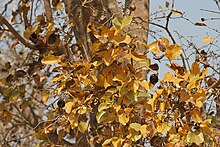Strychnine tree
| Strychnos nux-vomica | |
|---|---|
 |
|
| Illustration from Köhler's Medizinal-Pflanzen | |
 |
|
| Habitus | |
| Scientific classification | |
| Kingdom: | Plantae |
| (unranked): | Angiosperms |
| (unranked): | Eudicots |
| (unranked): | Asterids |
| Order: | Gentianales |
| Family: | Loganiaceae |
| Genus: | Strychnos |
| Species: | S. nux-vomica |
| Binomial name | |
|
Strychnos nux-vomica L. |
|
| Synonyms | |
|
|
The strychnine tree (Strychnos nux-vomica L.), also known as strychnine tree,nux vomica, poison nut, semen strychnos and quaker buttons, is a deciduous tree native to India, and southeast Asia. It is a medium-sized tree in the family Loganiaceae that grows in open habitats. Its leaves are ovate and 2–3.5 inches (5.1–8.9 cm) in size.
It is a major source of the highly poisonous, intensely bitter alkaloids strychnine and brucine, derived from the seeds inside the tree's round, green to orange fruit. The seeds contain approximately 1.5% strychnine, and the dried blossoms contain 1.0%. However, the tree's bark also contains brucine and other poisonous compounds.
Strychnos is promoted within alternative medicine as a treatment for many conditions, but the claims are not supported by medical evidence.
The use of strychnine is highly regulated in many countries, and is mostly used in baits to kill feral mammals, including wild dogs, foxes, and rodents. Most accidental poisoning is by breathing in the powder or by absorption through the skin.
Strychnos nux-vomica is a medium-sized tree with a short thick trunk. The wood is dense, hard white, and close-grained. The branches are irregular and are covered with a smooth ashen bark. The young shoots are a deep green colour with a shiny coat. The leaves have an opposite decussate arrangement, short stalked, are oval shaped, also have a shiny coat and are smooth on both sides. The leaves are about 4 inches (10 cm) long and 3 inches (7.6 cm) wide. The flowers are small with a pale green colour with a funnel shape. They bloom in the cold season and have a foul smell. The fruit are about the size of a large apple with a smooth and hard shell which when ripened is a mild shade orange colour. The flesh of the fruit is soft and white with a jelly-like pulp containing five seeds covered with a soft woolly substance.
The seeds are removed from the fruit when ripe. They are then cleaned, dried and sorted. The seeds have the shape of a flattened disk completely covered with hairs radiating from the center of the sides. This gives the seeds a very characteristic sheen. The seeds are very hard, with a dark gray horny endosperm where the small embryo is housed that gives off no odor but possesses a very bitter taste. The plant is native to southeast Asia and Australia normally in tropical and subtropical areas.
...
Wikipedia
